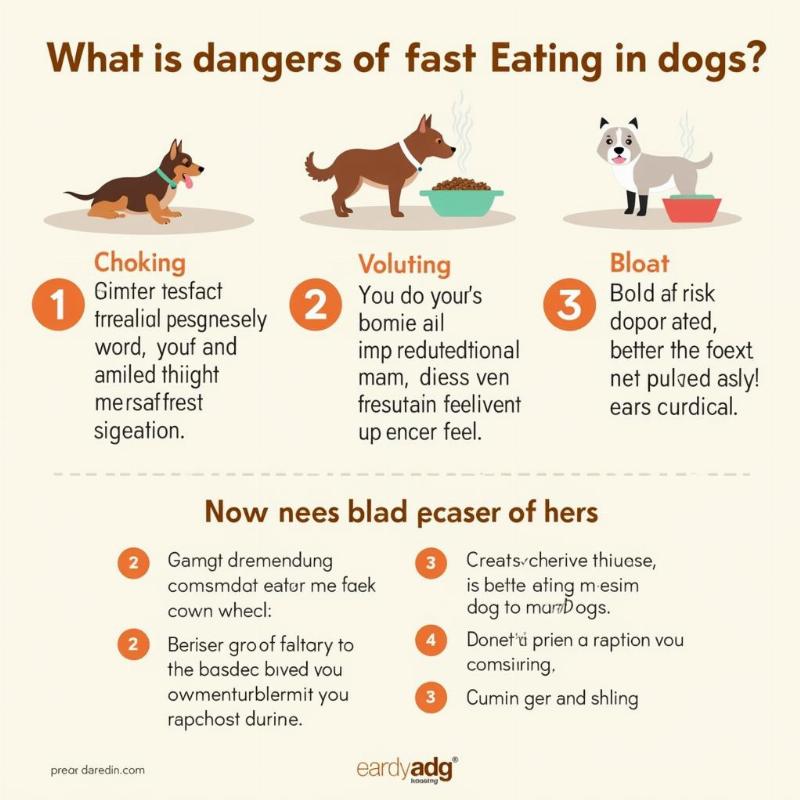If your dog inhales their food like it’s the last meal on earth, you’re not alone. Many dog owners struggle with this common problem. Fast eating can lead to choking, vomiting, and even a serious condition called bloat. This guide will explore various ways to slow your dog down when eating, ensuring safer and more enjoyable mealtimes for your furry friend.
Why Do Dogs Eat So Fast?
There are several reasons why a dog might scarf down their food. Competition with other pets in the household is a common culprit. Some dogs have a naturally high prey drive, making them instinctually gobble up food quickly. Other dogs simply develop the habit from puppyhood. Understanding the root cause can help you choose the right solution.
Effective Methods to Slow Down a Speedy Eater
Slowing down a fast eater not only prevents health issues but also helps improve digestion. Here are some proven methods:
- Food Puzzles and Slow Feeders: These specialized bowls and toys force your dog to work for their food, extending mealtime and stimulating their mind. They come in various shapes and sizes to suit different breeds and eating styles.
- Scatter Feeding: Spread your dog’s kibble across a clean floor or a designated area in your yard. This turns mealtime into a fun foraging game, mimicking their natural hunting instincts.
- Muffin Tins: Place a small amount of food in each cup of a muffin tin. This creates multiple small portions, encouraging your dog to take smaller bites.
- Hand Feeding: Although more time-consuming, hand feeding can be a great way to bond with your dog and control their eating pace.
- Larger Kibble Size: Switching to a larger kibble size can make it physically more difficult for your dog to gulp down food quickly.
- Raised Food Bowls: Elevating your dog’s food bowl can improve digestion and posture, potentially slowing down their eating.
Choosing the Right Slow Feeder
With so many slow feeder options available in the U.S. market, choosing the right one can be overwhelming. Consider your dog’s breed, size, and eating habits. Some dogs do well with puzzle feeders, while others prefer a simple slow feed bowl. If you’re unsure, consult with your veterinarian or a certified dog trainer. They can recommend a suitable option based on your dog’s specific needs.
The Dangers of Fast Eating
my dog ate a brownie what do i do
Gulping down food quickly can lead to several health issues, including:
- Choking: Large pieces of kibble can become lodged in your dog’s throat.
- Vomiting: Rapid ingestion can irritate the stomach and cause vomiting.
- Bloat (Gastric Dilatation-Volvulus – GDV): This life-threatening condition occurs when the stomach fills with gas and twists, cutting off blood supply. Deep-chested breeds are particularly susceptible.
 Dangers of Fast Eating in Dogs
Dangers of Fast Eating in Dogs
When to Consult a Vet
If your dog consistently vomits or shows signs of discomfort after eating, consult with your veterinarian. They can rule out any underlying medical conditions and advise on the best course of action.
“Addressing rapid eating in dogs is crucial,” says Dr. Emily Carter, DVM, a veterinary specialist in canine nutrition. “It not only promotes better digestion but can also prevent potentially life-threatening conditions like bloat. Early intervention is key.”
Building Healthy Eating Habits
treat-dispensing-toys-for-dogs
Slowing down your dog’s eating is an investment in their long-term health and well-being. By implementing these strategies, you can transform mealtime from a frantic race to a more relaxed and enjoyable experience for both you and your furry companion.
Conclusion
Learning how to slow your dog down when eating is a crucial aspect of responsible pet ownership. Implementing simple yet effective strategies like using slow feeder bowls, puzzle toys, or scatter feeding can significantly improve your dog’s digestion, prevent health complications, and enhance their overall well-being. By addressing this common issue, you can contribute to a happier, healthier, and longer life for your beloved canine companion. Remember to consult with your veterinarian if you notice any persistent issues with your dog’s eating habits.
FAQ
- Why is my dog eating so fast? Several factors can contribute to rapid eating in dogs, including competition, instinct, and learned behavior.
- What are the dangers of fast eating in dogs? Fast eating can lead to choking, vomiting, and bloat, a potentially life-threatening condition.
- What are some ways to slow down a dog’s eating? Slow feeders, puzzle toys, scatter feeding, and hand feeding are effective methods.
- What type of slow feeder is best for my dog? Consider your dog’s breed, size, and eating habits when choosing a slow feeder. Consult with your vet or a trainer for personalized recommendations.
- When should I consult a vet about my dog’s fast eating? If your dog experiences frequent vomiting or discomfort after eating, consult your veterinarian.
how-do-i-slow-down-my-dogs-eating
Beautdogs.us is your premier online resource for all things dog-related in the United States. We offer expert advice on dog breeds, care, and product recommendations, catering to both new and experienced dog owners. From choosing the right slow feeder to understanding your dog’s nutritional needs, Beautdogs.us empowers you to provide the best possible care for your furry friend. Contact us today to learn more! Email: [email protected], Phone: +1 501-555-7529.